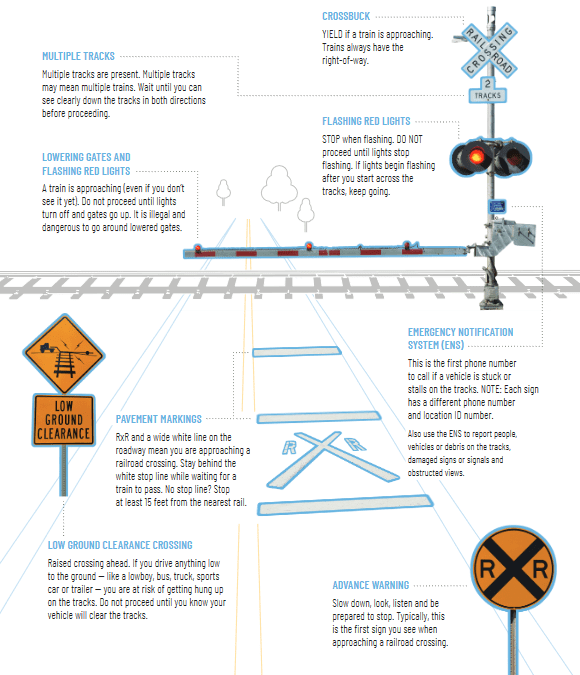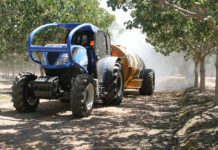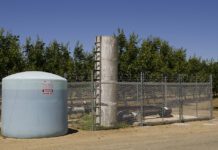
In June of this year, there were two tragic train crossing collisions involving vehicles that ended in serious injuries and numerous fatalities. Both incidents took place at unguarded railroad crossings and the individuals in the vehicles lost their lives. Unfortunately, these incidents are more common than one would think; every three hours in the U.S., there is a vehicle or person hit by a train. In these moments, it is imperative to invest time in reviewing railroad crossing procedures with all those within your sphere of influence to help ensure the safety of those on the train and as well as those individuals on the road. In this article, we will provide refresher information on railroad safety which will include important details about trains, discuss the signs and signals drivers and passengers should be aware of and safety procedures for maneuvering farm equipment over railroad tracks.
First and foremost, it is important to understand the sheer magnitude of trains. The size, weight and speed at which they travel make them a force to be revered. The average train weighs 200 tons, with the heaviest train weighing up to 6,000 tons. Passenger trains are limited to travelling 59 mph and freight trains can travel up to 49 mph. One factor to take into consideration is that it would take a train travelling at 55 mph the length of 16 football fields to come to a complete stop. At these speeds and weight, it is nearly impossible for a locomotive to avoid a collision with a vehicle or person on the tracks. It is also important to note that while passenger trains typically have a regular schedule, freight trains do not, so always expect a train at railroad intersections. Remember: trains always have the right of way over pedestrians, vehicles and even police and emergency vehicles.
Now that you are equipped with some basic locomotive knowledge, let’s discuss some of the signs and signals designed to keep those of us on the ground, in a vehicle or operating farm equipment safe while near or crossing railroad tracks. There are signs and warning systems before the crossing, on the road and at crossings that everyone should know.
Before the Crossing
Advance Warning Sign: yellow circle with black X and an R on either side. Warns drivers that the road crosses railroad tracks ahead and reminds the driver to slow down, look and listen for a train.
No Train Horn Sign: yellow rectangle sign with words. A Quiet Zone has been established and normally the train will not sound the horn. The locomotive engineer can still sound the horn in emergency situations or if workers are near the tracks.
Low Ground Clearance-Grade Crossing Sign: yellow diamond-shaped sign with a railroad and truck and trailer crossing tracks. Alerts drivers of long wheelbase vehicles or trailers of a potential hang-up situation at the crossing. All drivers need to make sure that their vehicle has cleared the tracks once they cross over.
Advance Warning Side Street Sign: yellow diamond-shaped sign depicting an intersection with railroad tracks. Warns that a highway-rail intersections will appear immediately after making either a right or a left turn. Reminds the driver to be prepared to stop if a train is approaching.
On the Road
Pavement Markings and Stop Bars: On paved roads, markings alert drivers that the road crosses railroad tracks ahead and identifies the safe place to stop and look for an approaching train. On gravel roads, there are no Pavement Markings or Stop Lines, and the driver must stop no closer than 15 feet.
Signs at the Crossing
Crossbuck Sign: white sign in the shape of an X with the words Railroad Crossing. Marks the crossing and should be considered the same as a YIELD. Most common sign at public highway-rail intersections.
Emergency Notification System: blue rectangle sign with emergency contact details. This is the railroad’s emergency phone number and USDOT Crossing Number. This is the first phone number to call if your vehicle/farm equipment is stuck on the tracks; if it is missing, call 911. Each crossing in the U.S. has a unique USDOT Crossing Number.
Multiple Track Sign: white sign in the shape of a reverse ‘T’ with a number. Indicates the number of tracks present. After one train has passed, look and listen for another train coming from either direction.
Devices at Crossing
Red Lights Flashing: Warns of an approaching train. When the red lights are flashing, a train is approaching. Stop and wait for the train to pass, then proceed when it is clearly safe to do so.
Flashing Red Lights and Gates: Warns of an approaching train and used to close the road when a train approaches. It is illegal to go around the gates. It is only legal to drive around lowered gates if the crossing is flagged by a law officer or railroad employee.
There are some special considerations for those working in agricultural regions where there are several railroad tracks in rural areas across our nation. Usually, railroad crossing in agricultural areas will be unguarded because they are deemed low-traffic areas. In the U.S., 46% of railroad intersections are unguarded, and this was the type of crossing in which those fatal incidents occurred earlier this summer. Keep the following steps in mind when approaching railroad crossings:
- Slow down as you approach a railroad crossing. Be prepared to stop.
- Stop no closer than 15 feet from the crossing.
- Look and listen for a train! You may not hear a train horn. Open cab windows and remove all distractions (i.e., turn off radio and fan, remove headphones, etc.) Rock back and forth in your seat to see around obstacles.
- Once you begin crossing the tracks, do not hesitate. Cross without stopping. If stuck or stalled on the tracks, evacuate immediately and call the number on the blue and white sign. Give the crossing identification number so the railroad knows your location.
If you are crossing with farm equipment, keep these things in mind:
- Check hitch pins to ensure they cannot dislodge while crossing and that your load is secure, so materials are not dislodged onto train tracks while crossing.
- Avoid tips and spills by making sure that farm machinery wheels are properly lined up with the railroad crossing surface. Stop no closer than 15 feet from the crossing and leave at least 15 feet between the front and rear of your vehicle and the nearest rail.
- Be aware that liquids or top-heavy grain wagons are prone to tipping.
Content for this article was sourced from Operation Livesaver, a non-profit organization that provides public education programs in states across the U.S. to prevent collisions, injuries and fatalities on and around railroad tracks and highway-rail grade crossings. If you interested in obtaining additional educational resources or trainings, please visit their website at www.oli.org.
For more information about worker safety, human resources, labor relations and pesticide safety, please visit www.agsafe.org, call (209) 526-4400 or email safeinfo@agsafe.org. AgSafe is a 501c3 nonprofit providing training, education, outreach and tools in the areas of safety, labor relations, human resources and workforce development for the food and farming industries. Since 1991, AgSafe has educated over 100,000 employers, supervisors and workers about these critical issues.











